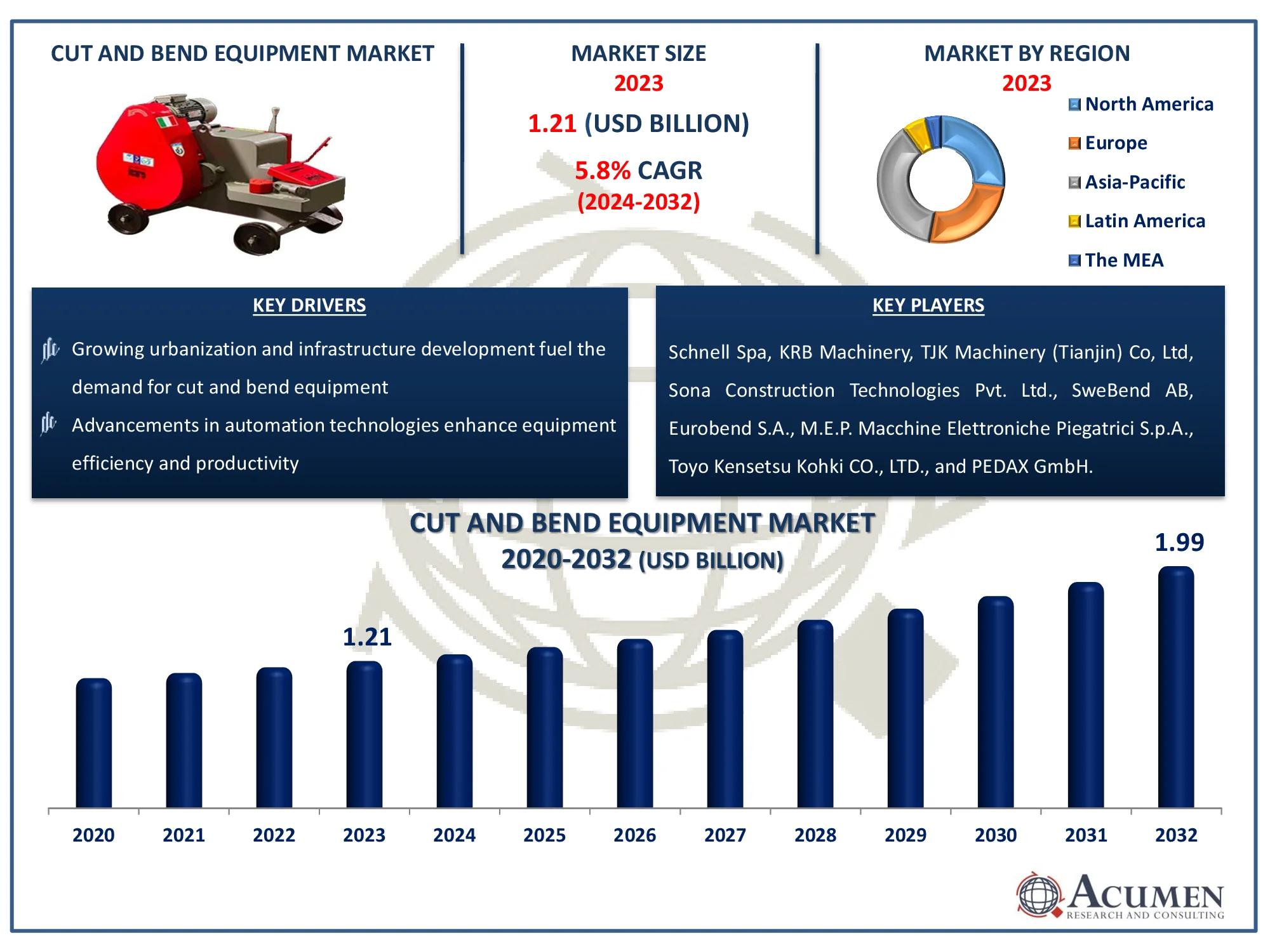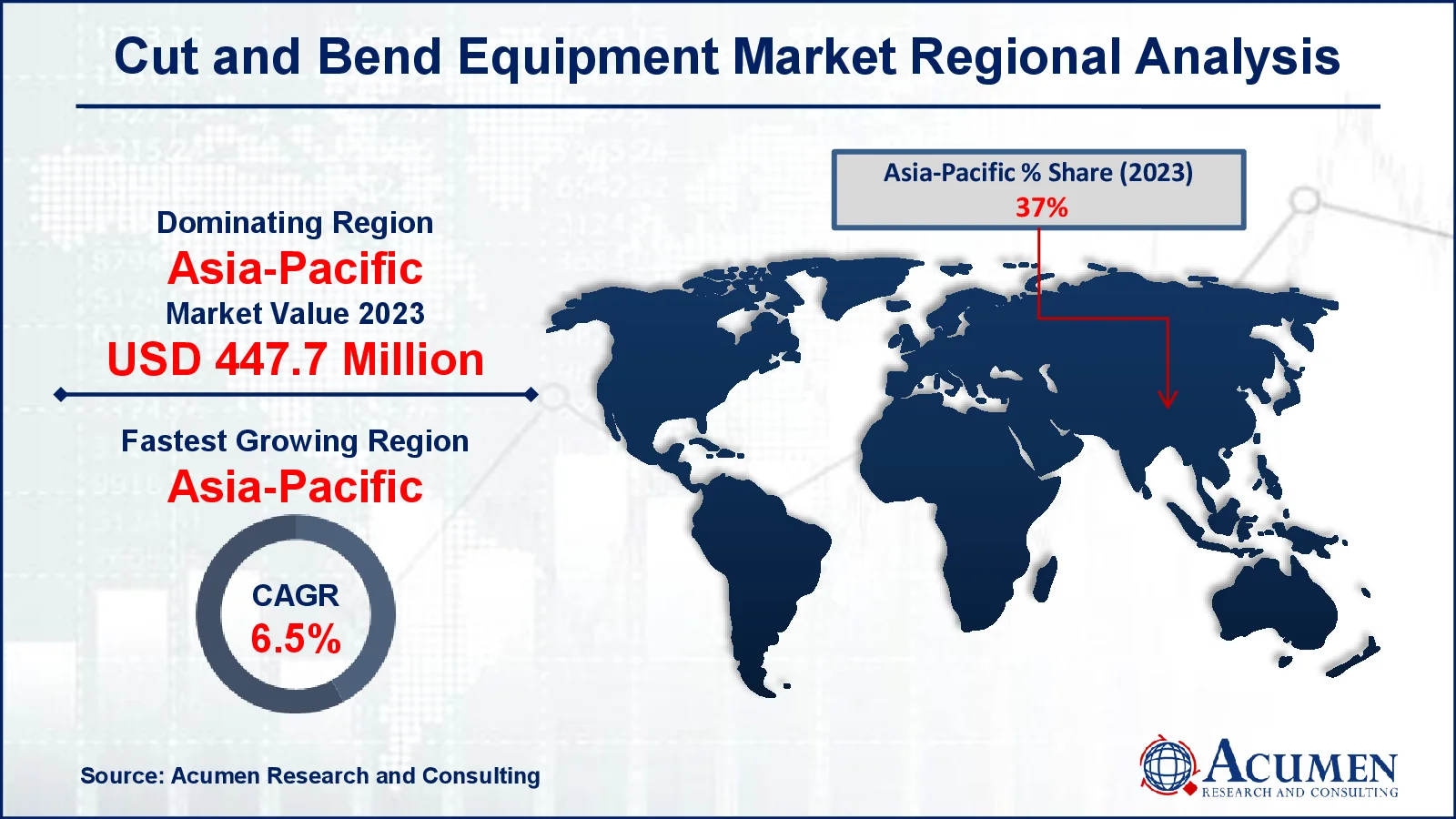July 2024
The Global Cut and Bend Equipment Market is expected to grow from USD 1.21 billion in 2023 to USD 1.99 billion by 2032, with a CAGR of 5.8% during the forecast period.
The Global Cut and Bend Equipment Market Size accounted for USD 1.21 Billion in 2023 and is estimated to achieve a market size of USD 1.99 Billion by 2032 growing at a CAGR of 5.8% from 2024 to 2032.
Cut and Bend Equipment Market Highlights

Based on its different shapes, sizes and quantities, the cut and bend machines have many applications in the building industry. For the cutting and bending purposes, cut & bend equipment is used. The equipment helps to better manage the inventory, which not only reduces the need for space to maintain bars, but also helps to save labor and waste costs. Due to the increasing popularity of cut-and-bending equipment for cutting, bending, shaping, meshing and others, demand for integrated reinforcement equipment is expected to increase over the cut and bend equipment market forecast period. Integrated equipment can carry out multiple operations with the application of spirals and rebar material such as cutting and bending, straightening and straightening.
Global Cut and Bend Equipment Market Dynamics
Market Drivers
Market Restraints
Market Opportunities
Cut and Bend Equipment Market Report Coverage
| Market | Cut and Bend Equipment Market |
| Cut and Bend Equipment Market Size 2022 |
USD 1.21 Billion |
| Cut and Bend Equipment Market Forecast 2032 | USD 1.99 Billion |
| Cut and Bend Equipment Market CAGR During 2023 - 2032 | 5.8% |
| Cut and Bend Equipment Market Analysis Period | 2020 - 2032 |
| Cut and Bend Equipment Market Base Year |
2022 |
| Cut and Bend Equipment Market Forecast Data | 2023 - 2032 |
| Segments Covered | By Product Type, By Operation Mode, By End-user, And By Geography |
| Regional Scope | North America, Europe, Asia Pacific, Latin America, and Middle East & Africa |
| Key Companies Profiled | Schnell Spa, KRB Machinery, TJK Machinery (Tianjin) Co, Ltd, Sona Construction Technologies Pvt. Ltd., SweBend AB, Eurobend S.A., M.E.P. Macchine Elettroniche Piegatrici S.p.A., Progress Holding AG, TabukSteel, Toyo Kensetsu Kohki CO., LTD., and PEDAX GmbH. |
| Report Coverage |
Market Trends, Drivers, Restraints, Competitive Analysis, Player Profiling, Covid-19 Analysis, Regulation Analysis |
Cut and Bend Equipment Market Insights
The growing demand is a direct consequence of shifting trends in the world's financial and production sectors. As Asia-Pacific's growing population and large markets for various vertical industries have driven businesses to move to these developing economies.The automotive industry and its auxiliary sectors are closely followed by the largest consumers of manufacturing equipment. Manufacturing companies Demand & offer is expected to increase over the forecast period for major industries in cut and bent such as aerospace and defence.
Global population growth drives energy consumption and demand. The demand for cut and bent equipment is expected to increase quickly by industrialisation. However, high costs for raw materials will constitute a significant constraint to the growth of the market. However, technological developments and efforts to develop customized equipment are anticipated in the near future to create business opportunities for producers.
The building materials market is encouraging growing infrastructure and building activities worldwide. Due to the rapid adoption of industrial Internet of Things in the Asia-Pacific region, industrial product manufacturers focus on the advanced technology products. In addition, increased awareness of better government initiatives and infrastructure resulted in a growth in construction, steel and, in turn, the market of cutting and bending equipment.
Cut and Bend Equipment Market Segmentation
The worldwide market for cut and bend equipment is split based on product type, operation mode end-user, and geography.
Cut and Bend Equipment Market By Product Type
According to cut and bend equipment industry analysis, the most substantial market share for cutting and forming machines. Stirrup equipment is currently the most common type of cutting and shaping machine, and it is expected to remain so in the next years. This is because the machine is improved by replacing standard stirrup machines with high-force stirrup machines.
Cut and Bend Equipment Market By Operation Mode
Automatic cutting and bending systems are a more convenient way to manufacture equipment because they require less user intervention and allow for faster processing (cutting, bending). The advantages include reduced labor requirements, increased speed, lower scrap, and increased output. However, compared to semi-automatic equipment, this equipment is more expensive. Automated machines are also more large due to the integrated components required for automated operations.
Cut and Bend Equipment Market By End-user
Constructors and engineering contractors play a key role in the end-users since bar processing, such as cuts and bends, is primarily done on building sites as needed. A number of reasons are driving the expansion of the cut-off equipment market, including rising need for cities in emerging nations, expanding global construction operations, and increased demand for steel products in the infrastructure and real estate sectors.
Cut and Bend Equipment Market Regional Outlook
North America
Europe
Asia-Pacific
Latin America
The Middle East & Africa

Cut and Bend Equipment Market Regional Analysis
The Asia-Pacific region has the biggest cut and bend equipment market share, thanks to fast urbanization and major infrastructural development, particularly in China and India. These countries are currently undertaking large-scale development projects such as residential complexes, commercial spaces, and transportation infrastructure, increasing need for efficient rebar cutting and bending solutions. in other hand, greater government infrastructure investments have greatly facilitated the adoption of these machines.
In Europe, strong building rules and an emphasis on sustainable construction techniques help to strengthen the business. Countries like Germany, Italy, and France make major contributions thanks to their well-established building industry and advanced automation technology. The demand for cutting-edge equipment that enhances precision and reduces labor costs has been a critical factor in regional growth.
North America follows closely, with rising infrastructure upgrades, including the renovation of aging bridges, roads, and public utilities. The U.S. government’s focus on infrastructure investments and the booming residential construction market are key drivers.
Cut and Bend Equipment Market Players
Some of the top cut and bend equipment companies offered in our report includes Schnell Spa, KRB Machinery, TJK Machinery (Tianjin) Co, Ltd, Sona Construction Technologies Pvt. Ltd., SweBend AB, Eurobend S.A., M.E.P. Macchine Elettroniche Piegatrici S.p.A., Progress Holding AG, TabukSteel, Toyo Kensetsu Kohki CO., LTD., and PEDAX GmbH.
Looking for discounts, bulk pricing, or custom solutions? Contact us today at sales@acumenresearchandconsulting.com
July 2024
August 2018
March 2024
April 2021